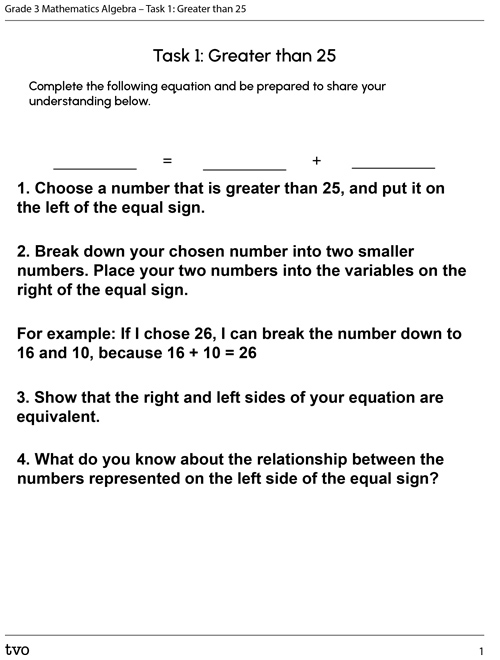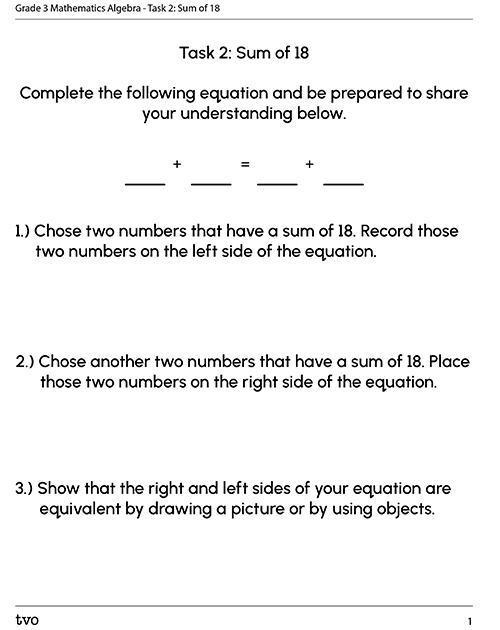Minds On
Variables and equations
Student Tips
Did you know?
The word variable means an unknown value.
For example:
In this example, is the variable, as it takes the spot for an unknown value or a missing number.
Let's check out this balance scale and equation with 3 missing numbers or variables.
After exploring the balance scale, reflect on the following questions:
- Consider the plus sign in this equation. What do you notice about this picture and this equation?
- How is it like other equations you have observed before? How is it different?
- Does the order of the blocks matter when adding them together?
Record your ideas in your notebook or another method of your choice.
Explore
Explore this video entitled "Find the Missing Number in Equations" to learn more about balancing equations.
Find the missing variables
Using the strategy that Teacher Shahana explained, make both sides of the equation equal, and balance the equation.
For this activity, you may wish to use tools like the hundreds chart or counters, like wooden shapes or small items to help count and support your thinking!
Use the interactive Hundreds Chart to help find the missing variables in the following equations.
Select the correct answer, then press ‘Check Answer’ to see how you did.
Action
Equation order
Designing a children’s play area
You might have noticed that the order in which the numbers are added will not affect the sum of that equation.
For example, 4 + 1 + 4 = 9 and 1 + 4 + 4 = 9
Also, numbers can be grouped together. So, the pair of fours could be doubled to give eight, then add the one, and the sum of nine remains.

Equal means balanced
You might have also noticed the relationship between the equal sign (=) and the balance scale.
When we show that something "equals" something, we are identifying that the sum of the parts on the left side of the equal sign is equivalent (or equal) to the sum of the parts on the right side of the equal sign.
Your turn!
You may wish to use a hundreds chart, counters, blocks, or another method of your choice to help count and support your thinking!
Task 1: Greater than 25
Consider this blank equation to complete the following task.

- Choose a number that is greater than 25, and put it on the left of the equal sign.
- Break down your chosen number into two smaller numbers. Place your two numbers into the
variables on the right of the equal sign.
- For example: If I chose 26, I can break the number down to 16 and 10, because
- Show that the right and left sides of your equation are equivalent.
Complete Task 1: Greater than 25 in your notebook or using the following fillable and printable document. You can also use a method of your choice.
Task 2: Sum of 18
Consider this blank equation to complete the following task

- Chose two numbers that have a sum of 18. Record those two numbers on the left side of the equation.
- Chose another two numbers that have a sum of 18. Place those two numbers on the right side of the equation.
- Show that the right and left sides of your equation are equivalent by drawing a picture or by using objects.
Complete Task 2: Sum of 18 in your notebook or using the following fillable and printable document. You can also use a method of your choice.
Task 3: Greater than 20
Consider this blank equation to complete the following task.

- Choose any two-digit number that is greater than 20. Put that number on the right-hand side of the equal sign.
- Break your chosen number down into three smaller numbers that add up to your chosen number.
- For example: If I chose 26, I can break the number down to 10, 10, and 6, because 10 + 10 + 6 = 26
- How would you add the numbers from Step 1 in order to make them easy to calculate in your
head? Is there a way you can group some of the numbers together?
- For example: If I chose 26, I can break the number down to 10, 10, and 6, because 10 + 10 + 6 = 26
- I know that 6 + 4 = 10 so 16 + 4 = 20
- It’s easier to add those two numbers together first and then I can add 5 to 20, so 5 + 20 = 25
Complete Task 3: Greater than 20 in your notebook or using the following fillable and printable document. You can also use a method of your choice.
Consolidation
Making connections

Student Success
Think-Pair-Share
If possible, with a partner, reflect on the following questions:
- How do you know if both sides of an equation are equal? Use an example to explain your thinking.
- What strategies did you use for composing and decomposing numbers?
- For Task 3, how did you use subtraction as a strategy in this problem? If you did not use subtraction, how is using subtraction a helpful strategy for finding missing variables or for checking over your work? Explain your thinking.
Note to teachers: See your teacher guide for collaboration tools, ideas and suggestions.
Reflection
How do you feel about what you have learned in this activity? Which of the next four sentences best matches how you are feeling about your learning? Press the button that is beside this sentence.
I feel...
Now, record your ideas about your feelings using a voice recorder, speech-to-text, or writing tool.


